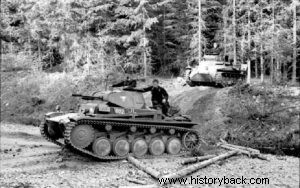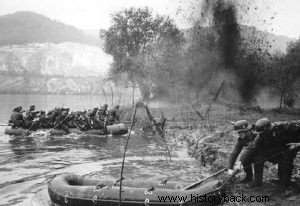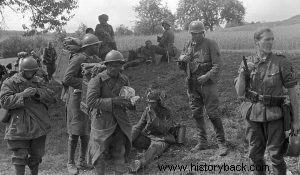
Hitler, since the Western Allies refused to recognize his conquest of Poland and insisted on war against Germany, was obliged to attack them. Time was working in favor of the West, at least as Hitler believed, because the German economy was also suffering and the Soviets were becoming more demanding every day.
Besides, every delay allowed the Anglo-French to strengthen their equipment and cover their weaknesses. So after the collapse of Poland, and with his eastern borders secured, Hitler began to transfer his forces to the West and at the same time to develop and rearm them.
Powers and plans
The light divisions operating in Poland were converted into armored ones. The motorized infantry divisions were increased to six. The SS would also participate with two other motorized divisions and the motorized reinforced regiment of the SS Leibstandarte Adolf Hitler.
But what forces were the Allies able to oppose against the German and especially against Hitler's fast-moving forces? The "strongest" component of the Western alliance was undoubtedly the French Army.
After its conscription the French Army extended some 94 divisions of each type. Another 10 divisions were sent by the British, 9 by the Dutch and 22 by the Belgians. The Dutch and Belgians, however, remained neutral and would remain neutral until May 10, 1940, when they received the unprovoked German attack.
Until that day no link existed between British - French and Belgians and Dutch, no understanding. Anglo-French forces were placed under French command. General Gamelin was appointed their commander-in-chief, with General Georges in command of the north-western front. The Anglo-French forces joined three army groups (AGs), which lined up along the Franco-German border.
In November 1939, however, the French commander-in-chief proposed a new battle plan - the "Diel case" - which provided for the entry of his forces into Belgium, up to the level of the river Dille, in case the Germans entered this small country.
He even made available – from March 12, 1940 – the 7th French Army to reinforce the Dutch, placing it at the extreme left of his formation. General Gamelin's new plan was put into effect on November 17 and all his units hurried to occupy their new positions.
The plan of the French commander-in-chief was in many ways risky to say the least. His main shortcoming lay in his lack of prior consultation with the Dutchman and his Belgian counterpart.
Four armies would have to, in the event of a German attack, link up and co-operate, under enemy pressure, without a predetermined battle plan and without any prior contact. The second serious drawback concerned the mission assigned to the 7th Army by the order of March 12.
From their starting positions this army, which was supposed to hasten to the reinforcement of the Dutch, had to travel a distance of 230 km to reach their ordered positions at Breda and the "Dutch Fort", the heart of the Netherlands.
On the contrary, the Germans had to travel a distance of only 100 km to reach the same location first. Gamelin's entire plan rested on the assumption that the resistance of the Belgians and Dutch would give him five days to establish his forces and achieve the necessary links. Army Group 1, which included the French 7th, 1st, 9th, 2nd Armies and the British Army (B.E.F), would therefore form the "attack" wing of the Allied forces.
The 7th Army would march to reinforce the Dutch, the 1st and British Armies would march into Belgium and take up positions along the River Deal, and the 9th and 2nd Armies would cover the front from the Belgian city of Namur to the French city of Sedan, at the height of the Ardennes forest.
These two armies would form the link point of the offensive and defensive wings of the allied forces. But could Army Group 1 really be considered the "offensive" wing of the Allies?
Including his reserves, the commander of 1st Division, General Bigot, had 36 infantry divisions, 3 light armored divisions, 4 divisions and 2 cavalry brigades. At the same time, behind the Mazinot line, the French commander-in-chief had ordered General Pretela's OS 2, which had 26 infantry divisions, 1 division and 1 cavalry brigade.
Finally, OS 3, which guarded the Rhine front and the Franco-Swiss border, had almost 30 other divisions. Altogether, including the Army of the Alps, which guarded the Franco-Italian border, the defensive fronts absorbed about 60% of General Gamelin's available means.
Another important element has to do with the quality of the French Army divisions. Of its 37 active divisions only 15 were allocated to OS 1. Another 9 were allocated to OS 2, as if the Mazino line did not exist, or was decorative. The French military leadership drew up a highly flawed plan of concentration, refusing to realize that permanent fortifications precisely offered them the possibility of saving means and men.
Also absurd is the fact that OS 1, the attacking group, was not endowed with the best divisions of the army, since they would bear the brunt of the struggle. A parenthesis should be made here regarding the quality "categories" of the French divisions.
French infantry divisions were divided into four categories:Active, Fortified, Reserve type A and Reserve type B. The manning and allocation of material to the divisions was based on the above distinction. Thus the type A divisions and especially those of type B were deplorably equipped and staffed. Especially in the category of anti-tank artillery, their deficiencies were enormous – they usually had only 30% of the weapons provided for in the composition tables, and others even less.
For example the 71st Infantry Division - type B - at Sedan had only 16 anti-tank guns of 25 and 47 mm. against the planned 60, while the B-type 55th Infantry Division, also in Sedan, had 21. The 60th Infantry Division – B-type – had replaced its 25mm anti-tank guns. with low muzzle velocity 37 mm guns. model of 1918.
These weapons fired a projectile weighing 400 grams with a muzzle velocity of 400 meters/second, which was unable to penetrate the frontal armor of German tanks, except the Pz I. All three mentioned divisions were attached to the 9th and 2nd Armies, which guarded the "impenetrable" by motorized forces Ardennes forest.
The 9th Army, under General Cora, had a total of ten divisions and brigades, organized into three army corps. The 2nd Army Corps had the 5th Motorized Infantry Division and the 4th North African Infantry Division. The corps would cover the crossings of the Meuse River at the height of Namur. On its right, the 11th Army Corps had the type A reserves of the 18th and 22nd Infantry Divisions.
The extreme right of the 9th Army consisted of the 41st Army Corps, which had the 61st B-Type Infantry Division and the 102nd Fortified Infantry Division, which manned the campaign works along the river bank. The army's reserve consisted of the also B-type 53rd Infantry Division. The vanguard of the 9th Army consisted of the 1st and 4th Cavalry Divisions and the 3rd Armored Brigade. These cavalry units were supposed to enter the forest of the Ardennes and conduct a delaying battle.
To the right of the 9th Army was the 2nd Army, under the command of General Udinje. The army had two army corps, the 10th – 55th and 71st Type B Divisions and 3rd North African Division – and the 18th – 41st Infantry Division, 3rd Colonial Infantry Division. It also had the 2nd and 3rd Cavalry Divisions and the 1st Colonial Cavalry Brigade. This mass of cavalry was supposed to act, in cooperation with the cavalry of the 9th Army, a delaying battle in the forest of the Ardennes.
The strange thing was that General Udize ordered his strongest divisions to the right of his location, which, however, was fortified with permanent and campaign works. Thus, for the unfortified sector of Sedan, the type B 71st and 55th Infantry Divisions were allocated.
This weakness was maximized by the fact that these weak divisions were covered on their left by the also weak 61st Infantry Division and the 102nd Fortification Division of the 9th Army. So the "inner" wings of the 9th and 2nd Armies consisted of three B-type divisions and a fortress division, while the sector's reserve, the 53rd Division, was also B-type.
Taking into account the meanderings of the river Meusi, the front that these four divisions had to cover reached a length of 85 km, that is, each division had to cover a front length of more than 20 km. Taking into account the catastrophic lack of these divisions in anti-tank weapons, we conclude to the conclusion that the density of anti-tank weapons on that front was only 5 guns per 2.5 square kilometers of terrain.
It is therefore not unnatural that from the moment the Germans crossed the river they literally pulverized the French divisions. Of course the top Allied leadership regarded the Ardennes sector as impenetrable to large tank formations. So, always in her opinion, there was no real danger of a split from this sector. But was it so?
The "impassable" Ardennes...
At dawn on May 10, 1940, the cavalry divisions of the French 9th and 2nd Armies had entered the forests of the Ardennes, ready to carry out the mission of reconnaissance and delay - if there was reason, which the French high command believed was not.
The French 2nd and 5th Cavalry Divisions – attached to the 2nd Army – advanced without initially encountering enemy forces. Before long, however, the 2nd Cavalry Division literally ran into powerful German tank forces. These were the armored forces of Gunderian's 19th Armored Army Corps.
By the afternoon of May 10 the French cavalry had been forced to retreat behind the Semois River. But the French 9th Army's cavalry also ran into strong German forces, forcing General Cora to order a retreat behind the main line of resistance on the Meuse.
Along with the cavalry, however, 25,000 refugees also crossed the French lines. The only positive of the day in the Ardennes was the success of the 3rd Belgian Ardennes Chasseur Regiment against the motorcyclists of the 7th Panzer Division, Rommel's chosen "ghost division".
The Belgians, after holding out as long as necessary, retreated normally towards their main line of resistance. In the meantime the RAF attempted to bomb the German phalanxes invading through the Ardennes. Of the 32 Fairey Battles sent out, 13 were shot down immediately and all the rest were rendered useless, without actually achieving their purpose. The German forces continued their movement almost undisturbed. How could it happen otherwise?
Could the 256 light armored vehicles of 4 French cavalry divisions take on some 2,400 German tanks? Clearly not, however bravely the French soldiers fought. As luck would have it, the Germans reached the eastern bank of the Meuse almost unmolested, with the exception of the Mézières region, where the units of the 102nd Fort Division held positions on the eastern bank of the river.
The French until the 12th of May were behind the Meuse, whose bridges they had blown up. It already seemed that the Germans had developed large forces in the Ardennes sector, beyond all expectation. Naturally, this news alarmed the French leadership and forced General Gamelin to order the deployment of two infantry divisions and the 3rd Armored Division to the 2nd Army.
These divisions were to man the second location of the 2nd Army by 17 May. However, these forces were disproportionately small, in relation to the size of the threat, and they would not arrive in time. Again the French leadership underestimated the capabilities of the enemy's fast-moving forces.
Precisely at 16.30 on May 12, the first German tanks reached the banks of the Meuse. These were tanks of Rommel's 7th Panzer. In fact, tanks of the 31st Tank Regiment almost crossed the river at that moment, pursuing the French.
However, the heroic intervention of the Belgian Lieutenant Vispreler, which cost him his life, brought about the destruction of the Yvoir bridge. Throughout the night of May 12-13, the German forces were occupying their advance positions for the following day. The Germans were moving with their vehicle lights on.
The French soldiers in their battle positions could hear the roar of the tank engines all night long. Allied air force again tried to hit the German forces. However, the heavy German anti-aircraft fire and the ubiquitous Messerschmitts did not allow it. That same night, however, Rommel's men discovered that there was a small gap in the French front in the area of Ou.
Theoretically the front there was garrisoned by the 5th Motorized Division and the 18th Infantry Division. The gap between the two French divisions was known and the commander of the 2nd Army Corps of the 9th Army, General Dufe, sent a reserve battalion - 2/39 - to cover the gap.
This battalion, however, was in no hurry to carry out its mission. He moved extremely slowly and finally did not occupy the ordered positions until the afternoon of May 12, without of course having time to organize the ground and form a plan of fire. Thus the small gap between the two French divisions remained an open wound on the French front.
Soon the bleeding from this wound could not be controlled. Rommel did not wait for the French to organize. That same night he sent the motorcycle battalion across the river. Indeed they succeeded and installed a small, insignificant bridgehead on the west bank of the Meuse. With losses of 24 dead and wounded, Rommel had broken through the main line of French defense. But worse would follow for the French. Until 03.00 Rommel was in Dinan.
At first light on May 13, the Stukas began a stormy bombardment of the French positions. Some uncoordinated French counter-attacks, even with tanks, were repulsed by Rommel's infantry, although they had no anti-tank weapons! A few hours later 15 German tanks crossed the river on ferries. In the meantime, Reinhart's 41st Armored Corps and Gunderian's 19th began to cross the river from the afternoon of May 13.
The French 42nd Colonial Demi-Brigade (regiment), in the Reinhardt sector of attack, heroically held their positions until the German tanks managed with direct fire to pulverize the French guns on the opposite bank of the river unmolested – at a distance of 100 to 120 m. In the Sedan sector also, Guderian's divisions began at the same time to cross the river.
The specific sector was defended by the 55th and 71st B-type divisions. At the selected crossing point, however, on a front of only 2,500 meters, 8 squadrons of German artillery and 12 squadrons of Stukas made an unprecedented preparation. The heavy anti-aircraft guns of the 88th supplemented the work of the aircraft and artillery, striking directly at the French active fences (cannons, observation posts) on the opposite bank. Nevertheless the French reserves fought as best they could until the Germans finally crossed the river.
Panic…
By nightfall the German divisions had occupied Vandelicourt and panic had gripped the French. The gunners of the Heavy Artillery Regiment of the 10th French Army Corps, panicked, abandoned their guns or at best blew them up and fled, spreading the rumor that the Germans had reached up to 8 km south of the Meuse River! strong> Of course no Gunderian chariot had passed the west bank of the river up to that time!
However, the construction work of a large floating bridge had already begun, by the bridge builders of the 1st Panzer. Ολόκληρη τη νύκτα οι Γερμανοί κατέβαλαν τεράστιες προσπάθειες για να κατορθώσουν να μεταφέρουν τα άρματα τους στην δυτική όχθη. Η επίπονη εργασία τους πράγματι επιβραβεύτηκε και με το πρώτο φως της 14ης Μαΐου τα γερμανικά άρματα βρίσκονταν πλέον πέραν του Μεύση. Οι Γάλλοι προσπάθησαν να ανατρέψουν το γερμανικό προγεφύρωμα.
Υπό τη διοίκηση του στρατηγού Λαφονταίν, οι γαλλικές δυνάμεις – 205ο και 213ο Συντάγματα Πεζικού και 4ο και 7ο Ανεξάρτητα Τάγματα Αρμάτων – διατάχθηκαν να εκτοξεύσουν άμεση αντεπίθεση. Ωστόσο, η σύγχυση ήταν τόσο μεγάλη ώστε η επίθεση δεν εκτοξεύθηκε παρά ώρες αργότερα και μάλιστα εντελώς ασυντόνιστα. Φυσικό αποτέλεσμα ήταν να αποτύχει εντελώς.
Σύντομα οι γαλλικές 55η και η 71η Μεραρχίες Πεζικού είχαν αφανιστεί. Το μικρό ρήγμα που είχε επιτύχει ο Ρόμελ στην Ου, το ρήγμα που είχε επιτύχει ο Ράινχαρτ στο Μοντερμέ και το μεγαλύτερο ρήγμα που είχε επιτύχει ο Γκουντέριαν στο Σεντάν, σύντομα θα ενώνονταν και θα αποτελούσαν ένα τεράστιο ρήγμα μήκους 130 χλμ. που θα «κατάπινε» τον γαλλικό στρατό.

Γερμανικά άρματα στο δάσος των Αρδεννών το 1940.

Γερμανοί στρατιώτες περνούν τον ποταμό Μεύση υπό τον φραγμό του γαλλικού πυροβολικού.


Στρατιώτες του Γαλλικού στρατού, γηγενείς Γάλλοι και Αφρικανοί, αιχμάλωτοι των Γερμανών.

Στοιχείο αντιαρματικού πυροβόλου των 25mm του γαλλικού στρατού.
